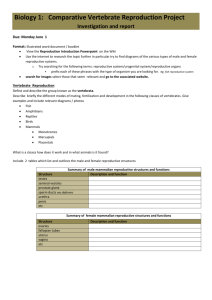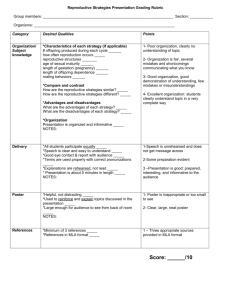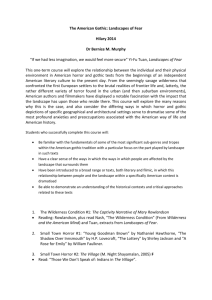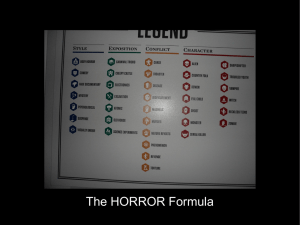Emily Jackson, Queen Mary, London, Assisted conception and the
advertisement
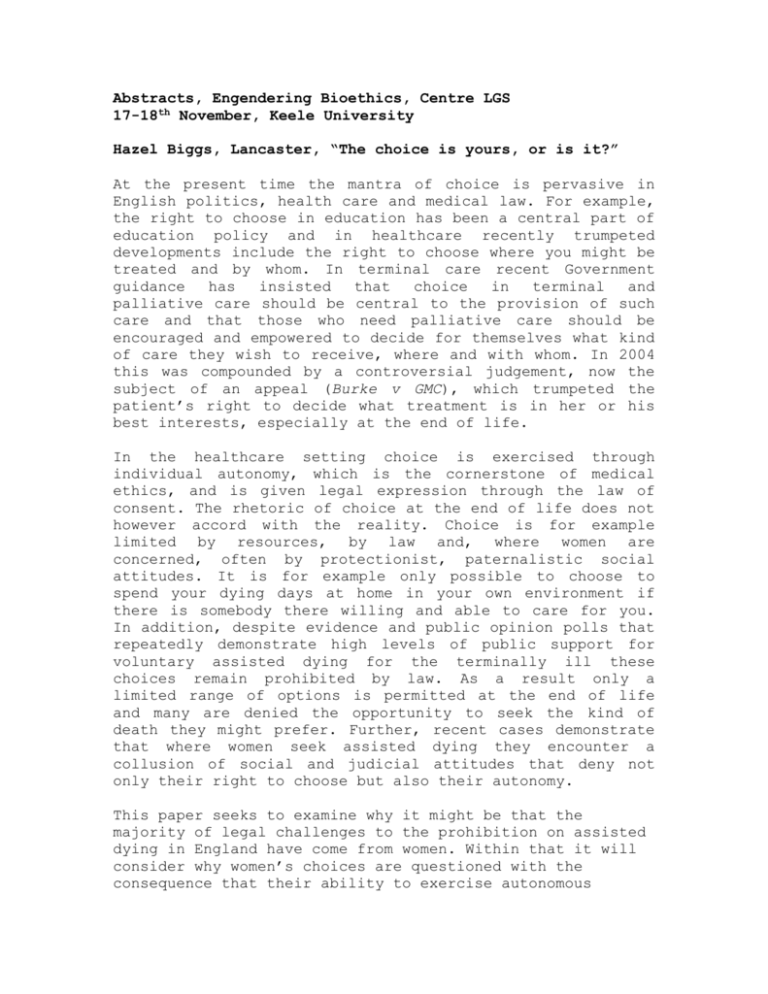
Abstracts, Engendering Bioethics, Centre LGS 17-18th November, Keele University Hazel Biggs, Lancaster, “The choice is yours, or is it?” At the present time the mantra of choice is pervasive in English politics, health care and medical law. For example, the right to choose in education has been a central part of education policy and in healthcare recently trumpeted developments include the right to choose where you might be treated and by whom. In terminal care recent Government guidance has insisted that choice in terminal and palliative care should be central to the provision of such care and that those who need palliative care should be encouraged and empowered to decide for themselves what kind of care they wish to receive, where and with whom. In 2004 this was compounded by a controversial judgement, now the subject of an appeal (Burke v GMC), which trumpeted the patient’s right to decide what treatment is in her or his best interests, especially at the end of life. In the healthcare setting choice is exercised through individual autonomy, which is the cornerstone of medical ethics, and is given legal expression through the law of consent. The rhetoric of choice at the end of life does not however accord with the reality. Choice is for example limited by resources, by law and, where women are concerned, often by protectionist, paternalistic social attitudes. It is for example only possible to choose to spend your dying days at home in your own environment if there is somebody there willing and able to care for you. In addition, despite evidence and public opinion polls that repeatedly demonstrate high levels of public support for voluntary assisted dying for the terminally ill these choices remain prohibited by law. As a result only a limited range of options is permitted at the end of life and many are denied the opportunity to seek the kind of death they might prefer. Further, recent cases demonstrate that where women seek assisted dying they encounter a collusion of social and judicial attitudes that deny not only their right to choose but also their autonomy. This paper seeks to examine why it might be that the majority of legal challenges to the prohibition on assisted dying in England have come from women. Within that it will consider why women’s choices are questioned with the consequence that their ability to exercise autonomous choice is compromised. Drawing on legal and philosophical literature it will argue that just because a person is perceived as occupying a vulnerable position does not mean they are unable to make an autonomous choice, nor should it mean that they are prevented from giving a valid consent and acting upon a choice that is truly their own. Mary Ford, Nottingham, “Bioethics and Gothic Horror” The Gothic horror literature of the late 18th and 19th centuries emerged in response to the culture of the ‘enlightenment’ and the social change of the Industrial Revolution. Gothic horror explored the sinister, negative side of the societal and cultural changes which were generally perceived as great improvements. Similarly, contemporary bioethics must respond to rapid technological and scientific change (what has been called the “reproduction revolution”). We can see bioethics emerging as a genre of gothic horror in the judgments of prominent medical law cases and in academic writing. Gothic horror operates within bioethical discourse in two ways. In some cases, illness / incapacity is presented as horror to elicit permissive attitudes to euthanasia, ‘saviour siblings’, etc. (see the cases of Bland, B v An NHS Hospital Trust, Pretty v UK, and Hashmi). In other areas, horror imagery and metaphor is utilised in the hope of encouraging restrictive attitudes – e.g. to cloning, xenotransplantation, etc. The use of horror in bioethics is often covert and implicit; its overt and explicit correlate is the use of arguments such as “X is unnatural”, or “X represents an affront to human dignity”, etc. In this presentation I will explore the interplay between the genres of bioethical discourse and gothic horror by demonstrating the use of horror-imagery in cases and academic commentary, and I will ask how this could shape social and legal responses to bioethical dilemmas. Marie Fox, Keele, “Franken Creatures: Legal Responses to genetically engineered animals” Biotechnological developments have always necessitated the sacrifice of animal bodies. Indeed vivisection played a key role in inaugurating experimental biology. The practices of vivisection and other clinical research involving animals have long been justified on the basis that the suffering and death of animals is ethically acceptable in pursuit of better health care for humans, although this rationale has coexisted with considerable ambivalence about the role of the scientist in this context and concerns about the possible use of human bodies in dissection. More recently, however, human interventions on animals in the name of biomedicine have assumed new forms with the introduction of xeno technologies and genetic engineering of animals, which have necessitated more direct interventions on the bodies of animals. Such developments have re-awakened earlier fears of the production of animal/human hybrids –an abhorrence which continues to underpin laws governing reproductive technologies. Yet at other sites in health care law, such as cloning, such fears are routinely downplayed. Notwithstanding the increasing use of genetically engineered animals in biomedicine, both as disease models and as source animals for new technologies, they have created scant ethico-legal attention. This paper seeks to assess the ethical and ontological challenges posed by genetic manipulation of animals and to examine how such creatures have been constituted in legal texts, such as those addressing the patentability of onco-mice. Patrick Hanafin, Birkbeck, London, “Disembodying Citizenship: Biopolitics and Gender in Contemporary Italy" In the 1990’s Italy was portrayed in the media as the “far west” as far as the governance of new reproductive technologies was concerned. This followed a series of media controversies involving doctors who promised motherhood to post-menopausal women and earned a lucrative living from the reproduction business. The general perception was that Italy was a country which did not regulate this field adequately leading to such mediatised aberrations. Instead of attempting to provide a facilitative legislative framework in the area of assisted reproductive technologies the law which was finally passed in 20041 creates a situation where a rigid doctrinal position is favoured over a workable regulatory model. The new Italian law on assisted reproduction prohibits testing of embryos for research purposes, freezing embryos and also outlaws pre-implantation diagnosis for preventing genetically transmitted diseases. The law also prohibits donor insemination, denies access to assisted reproductive Legge 19 febbraio 2004, n.40, “Norme in materia di procreazione medicalmente assistita”, (Gazzetta Ufficiale n.45 del 24 febbraio 2004). 1 technologies to single women and ordains that no more than three cells may be fertilised in vitro and that such cells be transferred to the womb simultaneously. Once couples agree on the treatment they will not be allowed to withdraw their consent. Moreover those doctors attempting to carry out procedures prohibited by the legislation face prison terms or fines and suspension from the medical register. As well as flying in the face of accepted societal norms of self-determination the text of the law paints a bleak picture of woman as reproducer first and foremost. It excludes other familial formations, such as gay and lesbian couples from the provision of reproductive technologies and thus has at its heart an ideal of the family which is at odds with the current societal reality. The introduction of the law witnesses the move from a “Far West” scenario to a “Mid-West” of legislative overregulation of female autonomy. This development is an intriguing and alarming case study of the way in which patriarchal institutional power can overcome accepted norms of autonomy in a pluralist society. This paper seeks to analyse how such a restrictive law could be seen as a rational workable solution to the lack of regulation. It will also seek to analyse the extent to which this law may be seen as part of a wider movement on the part of neoconservative forces to occupy the space of law. This involves the slow erosion of constitutional principles of dignity, equality, and female subjectivity. The implications of this law as paving the way for a narrowing of the existing abortion law will also be analysed. John A Harrington, Liverpool, “Citizenship and the Biopolitics of Post-Nationalist Ireland” In June 2004 voters in the Republic of Ireland endorsed a constitutional amendment to deprive children born on the island of Ireland of their previously automatic right to Irish citizenship. This change came amid increasing immigration and so-called 'baby tourism', whereby nonnational mothers were alleged to be coming to Ireland to give birth for the sole purpose of bestowing Irish citizenship on their children. This article sets the referendum in its historical and contemporary context. Along with recent jurisprudence of the Irish Supreme Court, the amendment betokens a distinctive biopolitics orchestrated according to neo-liberal themes consonant with Ireland's membership of the European Union and its foreign direct investment strategy. As such the amendment confirms the shift in Irish constitutional history from autarkic nationalism to cosmopolitan post-nationalism embodied in the Belfast Agreement of 1998. Emily Jackson, Queen Mary, London, “Assisted conception and the degendering of reproduction” By changing the ways in which we reproduce, reproductive technologies have the potential to alter previously immutable gender roles. When an embryo is stored in vitro, for example, there is no necessary reason to give the female partner the exclusive power to determine its fate, unlike when an embryo is in vivo, when there are clearly good pragmatic and ethical reasons to prioritise women's preferences. The creation of artificial gametes from stem cells will make it possible for same sex partners to create children who are genetically related to both of them, and human reproductive cloning, if it ever becomes lawful, would enable women (but not men) to reproduce without any help from the opposite sex. Artificial wombs are, however, still some way off, and so for the next few years pregnancy and childbirth will continue to be necessary and exclusively female contributions to the human reproductive process. So while reproductive technologies have the potential to transform and degender conception, they have rather more limited transformative potential once an embryo has been implanted in a woman's body. In this paper I will investigate the implications this uneven degendering of reproduction has for law. Jacquelyne Luce, PEALS, Newcastle, “Reproductive Rights and Reproductive Health: Ethnographic Narratives of Relations, Science and 'Life'” My first ethnographic observations took place in a midwifery practice in which midwives worked in an alegal situation providing care to women on a sliding-scale fee basis. Just a few years later, I worked within a rapidly shifting model of maternity care in which women articulated complex mediations of 'health' and 'normalcy' during pregnancy. In the late 1990s, my focus turned increasingly toward the intersection of same-sex rights legislation and developments in the field of assisted reproduction. In this paper, I will bring together some of these ethnographic moments in my history as a feminist anthropologist in Canada and the UK to explore the quite varied mobilisation of the concepts of 'rights' and 'health' by women wanting to become parents, midwives, physicians, journalists and activists. I will aim to explore the ways in which these concepts are both embedded in and displaced from narratives of relations, science and 'life' as they are recognised to be complementary, competing and contentious. Robin MacKenzie, Kent, “Apotemnophilia: Bodily Alteration, Autonomy and Harm” This paper explores how far medical and criminal law understandings can prove helpful in the context of troubled boundaries between voluntary and proscribed practices where bodily alteration are concerned. These shift with contingent understandings of medical condition, perversion and choice. Legal conceptions of autonomy, consent and harm are difficult to apply here, particularly where the treatment of a medical condition can be seen as involving mutilation which cannot be grounded in biological causation. Apotemnophilia is of particular interest here in that there is no agreement on its status as a medical or psychiatric disorder. Yet many people find the idea of immense unhappiness cured by the amputation of what is perceived as one or more superfluous limbs difficult to accept. As a consequence, those who wish to have such limbs amputated are faced with unpalatable choices. Some have attempted to perform the amputations themselves, with the possible involvement of emergency medical treatment services to ensure safety subsequently. Others have succeeded in obtaining treatment from health care professionals who may risk professional sanctions as a result. Jean McHale, Leicester, “Regulating Research – A genderneutral activity?” The volume of clinical research has vastly increased during the last two decades- so too has the desire to regulate research activity. Increasing emphasis is placed upon the rights of the individual in the research process, both nationally and internationally. There has been a shift, at least in the rhetoric, to regard the individual involved in research as a “participant” rather than as a “subject” submitting to research. There is far greater emphasis upon the need for informed consent and a movement from dominance in decision making to a dialogue between researcher and the individual who intends to be involved in this research. But who exactly is the research participant? Evidence suggests that while the amount of clinical research undertaken is ever increasing the involvement of women as participants in research remains comparatively limited. This paper explores why this may be the case. It questions to what extent the nature of research regulation in general and the governance arrangements for clinical research in England and Wales in particular operate to effectively engage with the gendered dimension of the research process. To what extent can/should participation in clinical research be gender neutral? Rupa Reddy, Westminster, “Motherhood, mental health and the death penalty” This paper will investigate the roles that maternal ideology and religion play in the treatment of mentally ill women who are sentenced to death for killing their children in the USA (to be amended). Andrew Sharpe, Keele, “England’s Common Law Monsters” This paper forms part of a broader project that aims to map the history of the common law category and legal fantasy Monster, a category that entered English law in the midthirteenth and survived till the mid-eighteenth century. The project is significant in at least four respects. First, it offers a legal history otherwise absent. Second, it highlights how the common law proves somewhat resistant to existing historical accounts of monsters. In particular, it challenges the applicability of Foucault’s genealogical treatment of monsters to English law. Third, it resists a view of the legal category monster as evidence of a legal Dark Age. Finally, it provides an historical vantage point from which to view and reflect upon contemporary practices of ‘normalisation.’ The project does not aim to answer fundamental questions concerning absolute and relative difference. Rather, it offers an opening through which to think about such questions. The legal category monster provides fertile ground for thinking about such questions because it precedes the Enlightenment and therefore now entrenched legal, cultural and medical understandings of difference. At the same time it perhaps functions, as Foucault suggests, as the principle of intelligibility for understanding all forms of contemporary abnormality, including those that run along vectors of gender and sexuality. The project will provide a close textual reading of England’s legal monsters and aims to trace specific anxieties that take shape and find expression within the common law. The legal history in question covers the writings of such legal luminaries as Henry de Bracton, Edward Coke and William Blackstone. However, for the purposes of this paper, and as a sample of this history, it is the year 1590 and the legal construction of monstrosity offered by Henry Swinburne that will be explored. Margrit Shildrick, “Anomalous bodies and governmentality: Difference engendering trouble” The paper will address the difficulty that legal, biomedical and ethical paradigms have in extending their governmental impulses to those bodies that fall outside the normative modernist standards of ‘clean and proper’ embodiment. The transhistorical notion of the monstrous, and of woman as monster, has largely faded, only to be replaced by anxieties about contemporary anomalous bodies including those of people with disabilities, asylum seekers and immigrants – and especially immigrant mothers, and those not-yet realised others who might be produced by reproductive bioscience. In focusing on disability, and in particular its troubling conjunction with sexuality where both lay and ‘official’ anxiety is acute and overt, I shall show that although authoritative discourse may reasonably claim to encompass simple difference, it struggles and ultimately fails to answer to the différance that implies a lack of clear distinctions between self and other. Stephen Wilkinson, Keele, “‘Family Balancing’, Sexism, & Sex Selection Because of technical improvements in our ability to screen and selectively use embryos and gametes, sex selection (parents choosing the sex of their future children) is likely to become easier and more effective in the near future. This raises moral questions about the permissibility of sex selection and ethico-legal questions about whether it should be prohibited &/or regulated (and, if so, how). This paper does not tackle directly the broad question of whether (‘nonmedical’) sex selection should be permitted. Rather, it critically assesses the view that ‘family balancing’ sex selection is better than other forms. ‘Family balancing’ (so-called) refers to cases in which parents wish to equalise the numbers of male and female children within a family. Thus, if a family with 6 girls and 1 boy chooses another boy, this would be ‘family balancing’, but not if it chooses another girl. Many of the standard objections to sex selection apply both to ‘family balancing’ and to other kinds of sex selection. For example, concerns have been raised about child welfare, about the commodification &/or instrumentalisation of children &/or reproduction, and about the child’s ‘right to an open future’. Other objections however are said to apply with less force, or not at all, to ‘family balancing’. Foremost among these are arguments deploying the idea of sexism, since (it is suggested) the motivation underlying ‘family balancing’ is generally not sexist, or at least it is less sexist than that underlying (many) other types of sex selection. The central thesis of this paper is that the alleged differences between ‘family balancing’ and other forms of sex selection either do not exist, or are less significant than is often supposed. More specifically, it is argued that: (a) ‘family balancing’ may be as vulnerable to sexism objections as (many) other forms of sex selection; (b) there are no (direct) reasons to privilege a preference for ‘balance’ over (say) a preference for uniformity; and (c) that permitting only ‘family balancing’ sex selection is not the only, or even the best, way of avoiding population sex imbalance.


